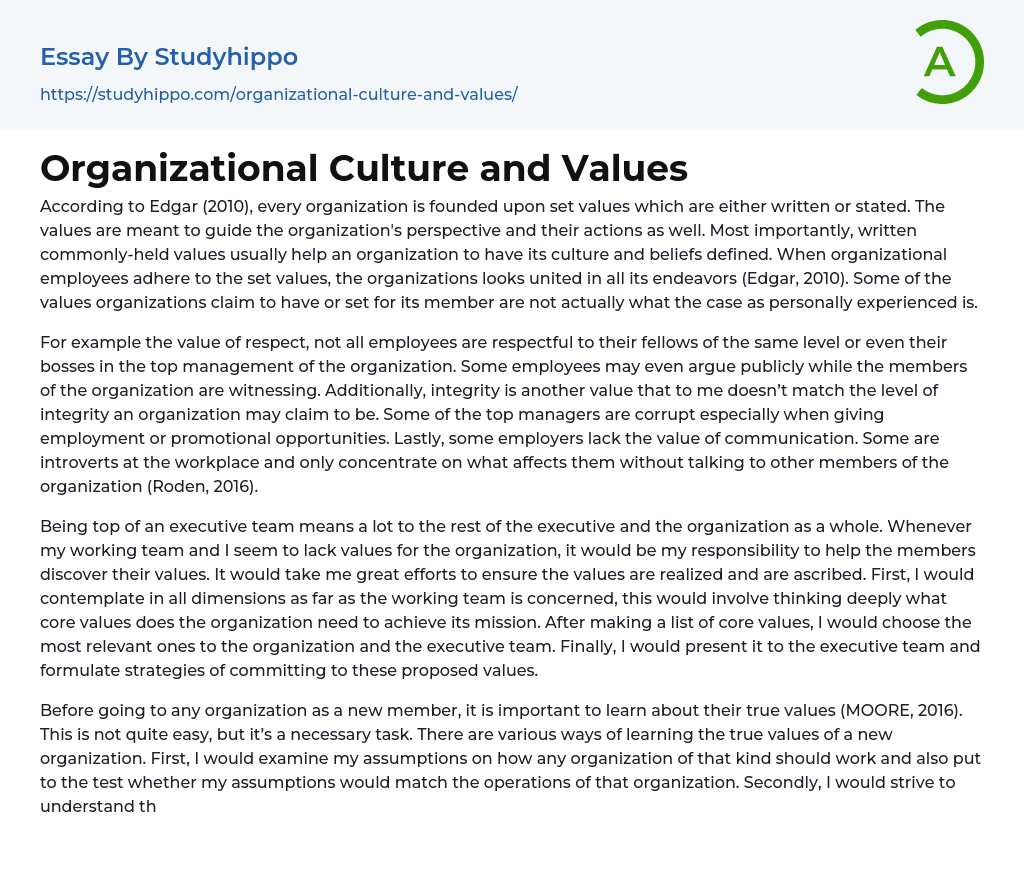According to Edgar (2010), organizations are built on established values that are either documented or stated. These values serve as a guiding framework for the organization's outlook and actions. Additionally, clearly articulated values help shape the culture and beliefs of the organization. When employees adhere to these values, the organization appears cohesive in all its pursuits (Edgar, 2010). However, some of the values that organizations claim to possess or expect from their members do not always align with personal experiences. For instance, the value of respect may not be consistently observed by all employees towards their peers or even their superiors in top management.
Several employees within an organization may openly argue, causing tension among their colleagues. Moreover, the level of integrity displayed by some top managers can be questionable, particularly when it comes to prov
...iding employment or promotion opportunities. Additionally, there are employers who lack effective communication skills, often remaining introverted and solely focusing on personal concerns without engaging with other members of the organization (Roden, 2016). Attaining a leadership position within an executive team holds significant importance for both the individual and the overall organization.
My role in the organization is to help my working team and myself ensure that we have the necessary values. This involves making an effort to help team members discover their values. To achieve this, I would deeply contemplate the core values that the organization needs for its mission. Once I have a list of core values, I would select the most relevant ones for the organization and our executive team. Then, I would present these values to the executive team and create strategies to commit to them. It is
crucial to understand an organization's true values before joining as a new member (MOORE, 2016).
Although not easy, this task is crucial as there are various ways to uncover the real values of a new organization. Initially, I would evaluate my assumptions on how the organization should operate and verify if they match the actual practices. Subsequently, understanding the employee culture within the organization would help me create a micro-culture that supports my work in the organization.
When analyzing an organization, it is crucial to assess the top management's execution of their duties and communication with lower-level employees. It would be advantageous to gather employee insights on the inner workings and dynamics between executives and staff. According to Wartzman (2016), a prosperous organization possesses a robust company culture, efficient leadership, and significant core values. These three components are interconnected in an organization.
Effective leadership in an organization promotes positive interaction between management and employees (Wartzman, 2016), fostering a healthy organizational culture where employees develop a cultural perspective when addressing issues. The establishment of a positive culture makes the values of the organization tangible (Wartzman, 2016).
References
- MOORE, M. (2016). Global Knowledge Training Blog » The Art and Science of Consulting. Global Knowledge Training Blog. Retrieved 14 September 2016, from http://blog.globalknowledge.com/professional-development/professional-skills/the-art- and-science-of-consulting/
- Roden, K. (2016). Dyer Unit 4- Cultures in Organizations. YouTube. Retrieved 14 September 2016, from https://www.youtube.com/watch?v=IQB3kaoOOGY
- Schein, Edgar. (2010).
Organizational Culture and Leadership (4th Edition). Jossey-Bass.
- All About Me essays
- Personal Growth essays
- Personal Values essays
- Strengths And Weaknesses essays
- Attitude essays
- Goals essays
- Personal Goals essays
- Personal Life essays
- Personality essays
- Principles essays
- Reputation essays
- Self Awareness essays
- Self Esteem essays
- Self Reflection essays
- Self Reliance essays
- Strengths essays
- Value essays
- Values essays
- Weakness essays
- Who Am I essays




